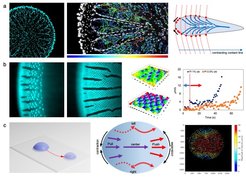
Soft condensed matter
We study evaporation to understand how it can lead to a certain self-assembly of macromolecules inside a liquid in small volumes, such as a droplet. We specially focus on the effect of salt in liquid-liquid phase separation and regular pattern formation. The outcome of the experimental works show the following insights:
Evaporation leads to phase separation and the formation of coacervates at the interface of the evaporating droplet. The salt interaction with the polymer phase result in formation of coacervates at the contact line of the droplet. Depending on the concentration of the polymeric monomers inside the droplet, the phase separation can result in formation of regular patterns such as a lattice pattern (https://arxiv.org/abs/2408.14129).
In an evaporating droplet containing a non-ionic polymer and salt, a phase separation occurs that is triggered by the salting-out effect in later phases of evaporation. The phase separation leads to a bursting flow and formation of flow vortices, which can result a flower-like deposition of the droplet components
(https://arxiv.org/abs/2409.07095).
Non-uniform evaporation of a surfactant-laden droplet can lead to formation of axisymmetric vortices inside the droplet, which can self-propel the droplet on a polymer brush. The propulsion then resembles the crawling dynamics of a cell on a substrate and suggests that fluid physics could play an important role in the crawling of living cells (manuscript under preparation).

